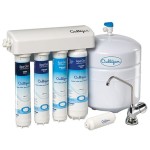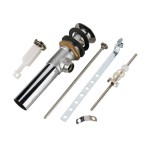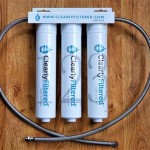What Is The Best Water Filter for Sink?
Access to clean, safe drinking water is paramount for maintaining good health. While municipal water systems are generally treated, concerns persist regarding potential contaminants like chlorine, lead, pesticides, and bacteria. Installing a water filter for your sink is a direct and effective way to improve the taste, odor, and purity of the water you consume and use for cooking.
The market offers diverse sink water filter options, each with its own set of features, filtration capabilities, and installation requirements. Selecting the "best" filter is highly subjective and depends on individual needs, water quality, and budget. This article will explore the different types of sink water filters, their advantages and disadvantages, and factors to consider when making a purchasing decision.
Before diving into the specific types of filters, it's important to understand the common contaminants addressed by these systems. These include:
- Sediment: Sand, rust, and other particulate matter that can affect water clarity and taste.
- Chlorine: Used for disinfection, but can impart an unpleasant taste and odor.
- Lead: A toxic heavy metal that can leach from old plumbing.
- Pesticides and Herbicides: Agricultural runoff that can contaminate water sources.
- Volatile Organic Compounds (VOCs): Industrial solvents and chemicals that can pose health risks.
- Bacteria and Viruses: Microorganisms that can cause waterborne illnesses.
The effectiveness of a water filter in removing these contaminants varies depending on the filtration technology employed.
Types of Sink Water Filters
The most prevalent types of sink water filters include faucet filters, under-sink filters, and countertop filters. Each type provides a distinct method of filtering water, tailored to varying requirements and preferences.
Faucet Filters: These are the most affordable and easiest to install. They attach directly to the faucet spout, allowing you to switch between filtered and unfiltered water with a simple lever or button. Faucet filters typically utilize activated carbon filtration to remove chlorine, sediment, and some volatile organic compounds (VOCs), improving taste and odor. However, they generally have a lower filtration capacity and flow rate compared to other types. The filter cartridges also require more frequent replacement.
Under-Sink Filters: These filters are installed beneath the sink and connect to the cold water line. They provide filtered water through a separate dedicated faucet. Under-sink filters offer a higher filtration capacity and flow rate than faucet filters and are often equipped with multiple filtration stages to remove a wider range of contaminants, including lead, cysts, and some pharmaceuticals. Installation is more complex as it requires basic plumbing skills, but the increased filtration performance and convenience make them a popular choice. Some under-sink models incorporate reverse osmosis (RO) technology for superior purification.
Countertop Filters: Countertop filters sit on the countertop and connect to the faucet spout via a hose. Similar to faucet filters, they are easy to install and require no plumbing modifications. Countertop filters typically offer a higher filtration capacity than faucet filters and often utilize multi-stage filtration. However, they take up countertop space and can be less aesthetically pleasing than under-sink models. They also require manually filling a container or operating a valve to dispense filtered water.
Key Considerations When Choosing a Sink Water Filter
Selecting the right sink water filter requires careful consideration of several factors to ensure the chosen system effectively addresses your specific needs and water quality concerns.
Water Quality: The first step is to understand the specific contaminants present in your water. You can obtain a water quality report from your local municipality or conduct a private water test. This information will help you identify the contaminants you need to target and determine the filtration capabilities required. For example, if lead is a concern, you need a filter certified to remove lead. If you are primarily concerned about taste and odor, a simple activated carbon filter might suffice.
Filtration Technology: Different filters employ various filtration technologies, each with its strengths and limitations. Activated carbon is effective for removing chlorine, sediment, and some VOCs. Reverse osmosis (RO) offers the highest level of purification, removing a wide range of contaminants, including dissolved solids, heavy metals, and bacteria. Sediment filters remove particulate matter. Understanding the capabilities of each technology is crucial for selecting a filter that effectively addresses your water quality concerns.
Flow Rate and Capacity: These factors determine how quickly the filter dispenses water and how long the filter cartridge will last. Flow rate is measured in gallons per minute (GPM). A higher flow rate means you can fill a glass or pitcher faster. Capacity is measured in gallons and indicates how many gallons of water the filter can effectively treat before the cartridge needs to be replaced. Choose a filter with a flow rate and capacity that meets your household's water usage needs. Regularly replacing filter cartridges is essential for maintaining water quality and preventing the filter from becoming a breeding ground for bacteria.
Specific Filtration Technologies Explained
A deeper understanding of the technologies used in sink water filters helps inform the best choice for individual needs. These differing technologies offer different strengths and are effective against different contaminants.
Activated Carbon Filtration: This is one of the most common and cost-effective filtration methods. Activated carbon is a form of carbon that has been treated to have a large surface area, allowing it to adsorb a wide range of contaminants from water. Activated carbon filters are effective at removing chlorine, sediment, volatile organic compounds (VOCs), and improving the taste and odor of water. There are two main types of activated carbon filters: granular activated carbon (GAC) and carbon block filters. Carbon block filters are generally more effective because they have a higher density and allow for greater contact time between the water and the carbon.
Reverse Osmosis (RO): RO is a membrane filtration process that uses pressure to force water through a semi-permeable membrane, leaving contaminants behind. RO systems are highly effective at removing a wide range of contaminants, including dissolved solids, heavy metals, pesticides, herbicides, and bacteria. RO systems typically include multiple stages of filtration, including a sediment filter, an activated carbon filter, and the RO membrane. RO systems also produce wastewater, which is typically discharged down the drain. The ratio of filtered water to wastewater varies depending on the system, but it is typically around 1:3 or 1:4.
Sediment Filtration: Sediment filters remove particulate matter from water, such as sand, rust, and silt. They are typically made of pleated paper, spun polypropylene, or other porous materials. Sediment filters are rated by their micron rating, which indicates the size of the particles they can remove. A lower micron rating means the filter can remove smaller particles. Sediment filters are often used as a pre-filter in multi-stage filtration systems to protect other filters from clogging.
Ultraviolet (UV) Disinfection: UV disinfection uses ultraviolet light to kill bacteria and viruses in water. UV systems do not remove contaminants from water; they only disinfect the water. UV disinfection is an effective way to eliminate waterborne pathogens without adding chemicals to the water. UV systems typically include a UV lamp and a flow chamber where the water is exposed to the UV light. The UV lamp needs to be replaced periodically, typically every 12 months.
Ion Exchange: This process exchanges unwanted ions in the water for other, less harmful ions. A common application is water softening, where calcium and magnesium ions are exchanged for sodium ions. While effective for softening water, it is not typically used for general contaminant removal. Ion exchange resins have a limited capacity and need to be regenerated periodically.
Ceramic Filtration: Ceramic filters use a porous ceramic material to physically filter out bacteria, protozoa, and sediment. They are often used in portable water filters for camping and hiking, but are also available for sink applications. Ceramic filters can be cleaned and reused multiple times, making them a cost-effective option for removing microorganisms from water.
Ultimately, the "best" sink water filter is the one that effectively addresses your specific water quality concerns, fits your budget, and meets your household's water usage needs. Researching different types of filters, understanding the contaminants in your water, and consulting with a water treatment professional can help you make the right choice.

7 Best Water Filters For Your Sink 2024 Review The Good Trade

The Best Under Sink Water Filter For 2025 Reviews By Wirecutter

7 Best Water Filters For Your Sink 2024 Review The Good Trade

The Best Under Sink Water Filter For 2025 Reviews By Wirecutter

6 Best Under Sink Water Filters Of 2025 According To Testing

5 Best Water Filters Of 2025 Tested Reviewed

8 Best Under Sink Water Filters Of 2024

7 Best Water Filters For Your Sink 2024 Review The Good Trade

7 Best Water Filters For Your Sink 2024 Review The Good Trade

Top 10 Best Under Sink Water Filters In 2025







